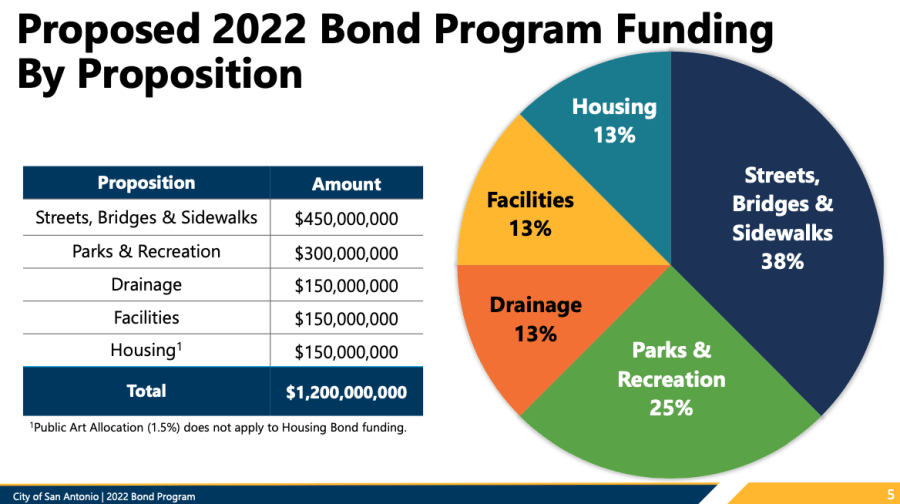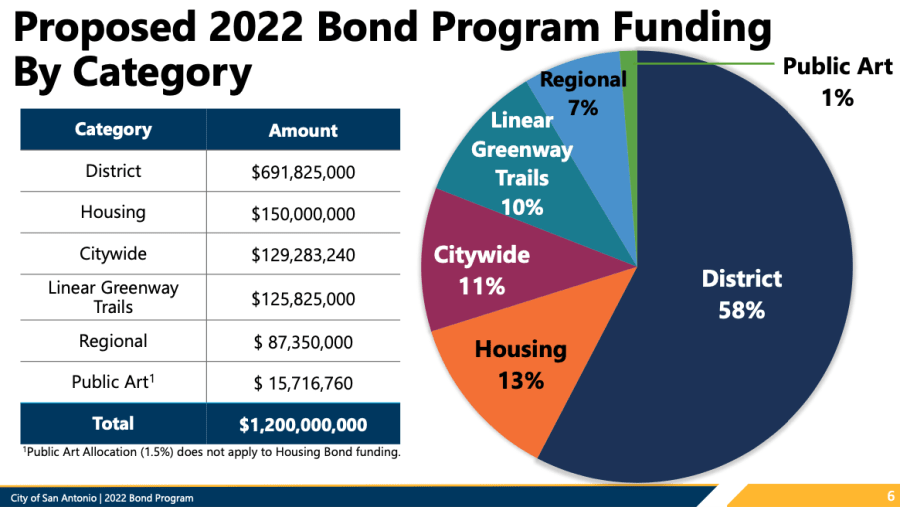SAN ANTONIO – The first step in a months-long process for the 2022 bond program was a shaky one on Wednesday as city council members criticized city staff’s proposed list of projects - both for what made the cut, and what didn’t.
The city’s five-year bond programs are a chance to tackle larger projects like street reconstructions or new buildings. The recommendations for the $1.2 billion program city staff presented to council members on Wednesday included big investments on basic infrastructure, money to build out the city’s greenway trails system, and an allotment for a new area - housing.
The recommendations are a starting point as council-appointed community committees and ultimately city council itself will tweak the program before it ends up in front of city voters in the May 2022 municipal election.
The 2022 bond is 41% bigger than the last five-year program, which voters approved in 2017. Despite its record size, city staff have said the number of projects submitted for inclusion in the bond program far outweigh the money that’s available.
The project requests put forward by council members, staff, community partners, public agencies, and the public totaled $2.8 billion - more than double what’s available. The city’s total infrastructure need, not including any housing projects, is more than five times as much - $6.6 billion.
City staff recommended spreading the $1.2 billion total around five areas:
- Streets, Bridges & Sidewalks - $450 million
- Drainage & Flood Control - $150 million
- Parks & Recreation - $300 million
- Facilities - $150 million
- Housing - $150 million
But as council members dug into some of the individual projects recommended within those areas, there were many pointed questions and comments about what was included, or excluded, and how it was all chosen.
“I don’t think a city coming out of a pandemic that has struggled to work is going to be interested in funding some of these programs that are considered ‘citywide’ under parks,” said District 3 Councilwoman Phyllis Viagran.

WHAT’S IN IT NOW?
City staff’s proposal is not the final version of what will be contained in the bond program, but it will be the basis of what comes next.
Because of council members’ emphasis on basic infrastructure, City Manager Erik Walsh said staff have recommended funneling half of the record budget toward streets, bridges, sidewalks, and drainage. That includes $100 million for failed streets.
The $300 million parks and recreation allotment contains $126 for further development of the Howard Peak Greenway Trails System, including connector projects suggested by the group Activate SA. The trails system’s development used to be funded with a 1/8 cent sales tax, but voters agreed last year to divert that money to a workforce training program and then to transportation.
Walsh says there’s still about $200 million worth of work to do on the trails system, not including the additional work that Activate SA has proposed, and the city plans to complete the original vision of the system through this bond program and the next in 2027.
The city is also pursuing a new area for the bond program, which voters approved through a charter change earlier this year - affordable housing. The city is aiming to preserve or produce roughly 28,000 housing units over the next 10 years.
Though staff had originally proposed $250 million to be spent on housing in this bond program, Assistant City Manager Lori Houston says they believe $150 million will be enough to hit half of the city’s preservation and production goal over the next five years when combined with another $1.45 billion in available resources.

Those other resources include: the city’s annual budget, the San Antonio Housing Authority, the San Antonio Housing Trust, tax exemptions, developer-initiated Tax Increment Reinvestment Zones (TIRZ), and $1.1 billion in federal tax credits for private affordable housing developments.
Since not all of the requested projects could be covered under the bond, staff recommended pursuing $77 million worth of projects through TIRZ funding and another $38 million for drainage projects with a stormwater fund to help relieve some of the pressure.
City staff are also recommending increasing the city’s allocation in the bond for public art from its usual 1 percent level to 1.5 percent for a total of $15.7 million. However, that percentage would only be applied toward roughly $1 billion of the bond program - everything except the housing portion.
Though it wasn’t included in the project lists, Walsh told council members that staff were still trying to figure out how to add in a project at Port San Antonio, which had requested $30 million in street work.
Here’s the current list of projects:
WHAT’S THE PROBLEM?
Several council members had issues with the staff recommendations from a perceived lack of funding for streets or drainage work to projects they didn’t deem worthy - like a basketball and volleyball practice facility at UTSA.
“Hey, I’m a grad from UTSA,” said District 9 Councilman John Courage. “I enjoy the football games, but I’m not willing to spend another $10 million on another athletic facility when I’ve got $11 million worth of drainage in my district that’s going into people’s homes that I would also like to see handled.”
A common target was the $255 million worth projects listed as “citywide,” which include everything from the $126 million in trail system developments, $20 million toward the overhaul of the Sunken Garden Theater, or a $6 million renovation of the central library.
As council members focus on bringing more money for their districts, especially with infrastructure, some suggested significantly cutting the citywide projects and spreading that money out among the districts.
“I, in good faith, cannot support a bond package that only has one drainage project for District 5 when all I hear from my constituents is their concerns about drainage flooding and how it impacts their foundation, and it’s causing their homes and their rental properties to shift,” said Councilwoman Teri Castillo, who recommended cutting the amount for citywide projects in half.
District 10 Councilman Clayton Perry agreed with Castillo and also mentioned reducing money meant for affordable housing.
“I want to make sure that my neighbors in District 10 are satisfied with the job that we’re doing up here on this stage to make sure that they’re getting the things that they want, need and are paying for,” Perry said.
Mayor Ron Nirenberg, however, warned against falling back into the city’s previous form of budgeting by proportion between the districts.
“We know that that’s not how you budget a household, and it certainly isn’t supposed to be how you budget the city. You allocate the resources where the needs are. And as we’ve mentioned before, we have more needs than we have more resources,” Nirenberg said.
“And so unless we’re ready to declare everything else besides streets to be a priority, we better be prepared to spend $1.2 billion on streets alone and watch all of our facilities, our parks and everything else decay into a state of disrepair. I’m not ready to do that. And in fact, I don’t think San Antonio residents want us to do that.”
District 8 Councilman Manny Pelaez told his council colleagues that the best version of a “consensus document” is one that makes everyone unhappy.
“I think, you know, we’re going to have an excellent document because it’s going to make every one of us unhappy.” Pelaez said with a laugh. “And that’s a good thing. And that’s the way it should be. That’s the way deliberative democracy works.”
WHAT’S NEXT?
Walsh told reporters after the meeting he would check his notes on the council’s comments for how the recommendations would be adjusted.
“There are tweaks, and there are some things that that I’m not going to recommend we tweak, and then I’ll need to come back to council,” Walsh said.
Walsh and Nirenberg both said during the meeting they hadn’t heard any dramatic changes to the overall level of funding for the different areas of the bond, indicating those bottom line figures will likely stay the same.
The proposed list of projects will go next to a group of five, 32-member committees to refine. Each will focus on a specific area of the bond program and be made up of three appointees from each district and a pair of co-chairs appointed by the mayor.
Nirenberg will also appoint a set of tri-chairs to oversee all five committees.
The committees will meet from October to December and make their final recommendations to the city council. The council is expected to review the recommendations in January.
Perry, who served on the streets, sidewalks and bridges committee for the 2017 bond, warned his council colleagues that “you will not see hardly any changes at all out of these committees.”
“So basically, they’re going to take a look at work, what we’re recommending - what the city staff is recommending - rubber stamp, it goes. So there are some tweaks in that. But generally that’s what’s going to happen,” he said.
After city council approves a final list of projects for the bond program, it’s expected to vote in February to order an election for May 2022, when voters will have the ultimate say.
Though there are five general areas, there will be six propositions, since city staff say state law requires municipal facilities like libraries to be listed separately from public safety facilities like police substations.

